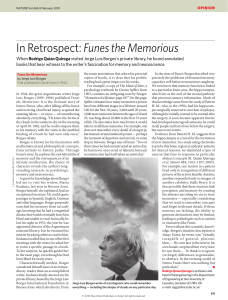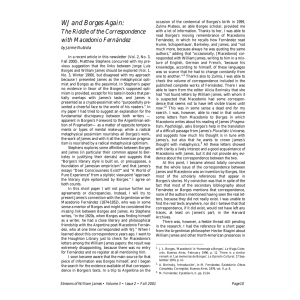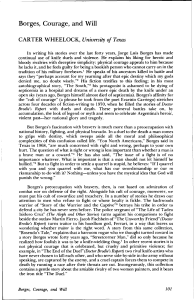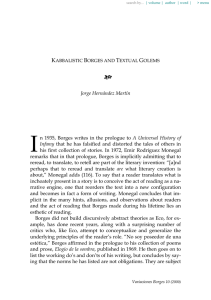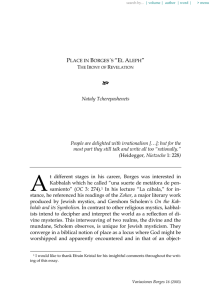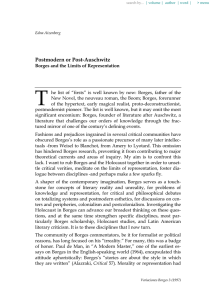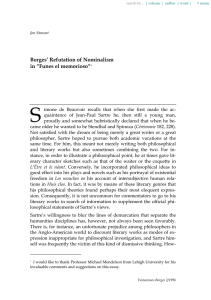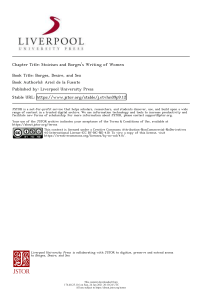Borges and The Gangs of New York
Anuncio
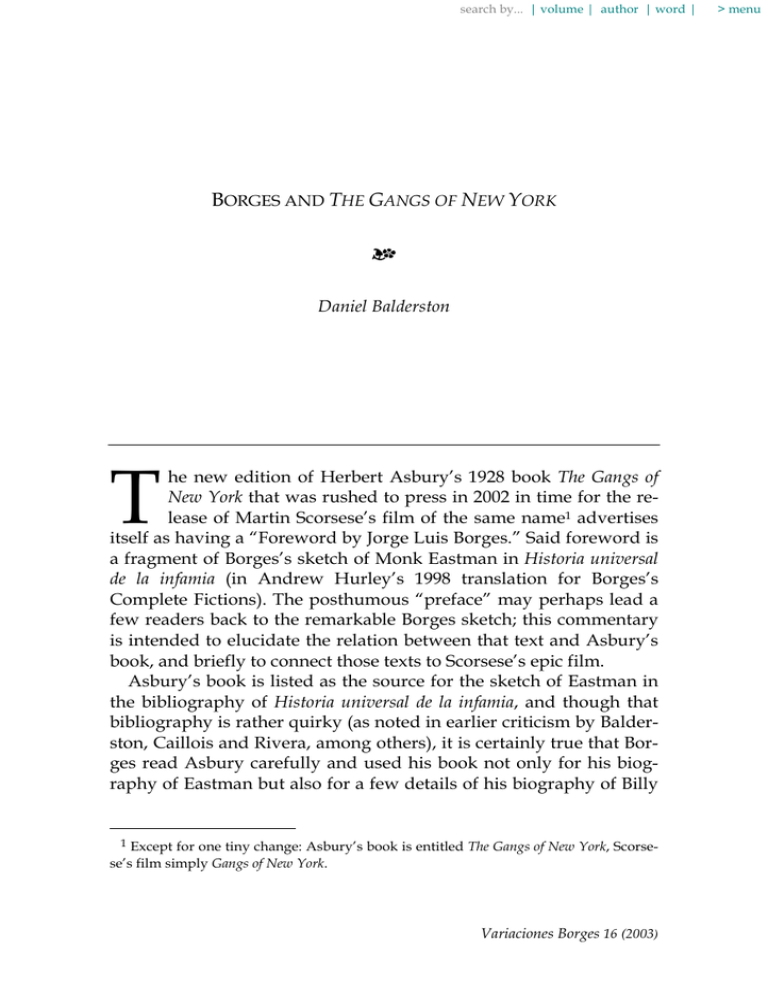
search by... | volume | author | word | BORGES AND THE GANGS OF NEW YORK w Daniel Balderston T he new edition of Herbert Asbury’s 1928 book The Gangs of New York that was rushed to press in 2002 in time for the release of Martin Scorsese’s film of the same name1 advertises itself as having a “Foreword by Jorge Luis Borges.” Said foreword is a fragment of Borges’s sketch of Monk Eastman in Historia universal de la infamia (in Andrew Hurley’s 1998 translation for Borges’s Complete Fictions). The posthumous “preface” may perhaps lead a few readers back to the remarkable Borges sketch; this commentary is intended to elucidate the relation between that text and Asbury’s book, and briefly to connect those texts to Scorsese’s epic film. Asbury’s book is listed as the source for the sketch of Eastman in the bibliography of Historia universal de la infamia, and though that bibliography is rather quirky (as noted in earlier criticism by Balderston, Caillois and Rivera, among others), it is certainly true that Borges read Asbury carefully and used his book not only for his biography of Eastman but also for a few details of his biography of Billy 1 Except for one tiny change: Asbury’s book is entitled The Gangs of New York, Scorsese’s film simply Gangs of New York. Variaciones Borges 16 (2003) > menu search by... | volume | author | word | 28 DANIEL BALDERSTON the Kid.2 Not only the broad strokes of Borges’s portrait of Eastman derive from Asbury but also many of what Borges termed at the time the “circumstantial details” (“rasgos” or “detalles circunstanciales”) that serve, as he explains in “La postulación de la realidad” and “El arte narrativo y la magia,” to help the reader evoke a more complex idea of the character than can be described economically in psychological terms.3 In the case of the sketch of the man Asbury calls “the prince of gangsters,” Eastman’s love of pigeons and cats is a vital piece of information that Borges will use inventively to go beyond the information about Eastman that he read in Asbury. As I showed some years ago in my work on the sources of another of the sketches in Historia universal de la infamia, that of the Tichborne Claimant (“el impostor inverosímil Tom Castro”), Borges was particularly interested when he retold the stories he had read in the works listed in the bibliography to emphasize those scenes which had visual power.4 Each of the stories in the book, however closely based on the source material, contains a few sharp scenes that are not to be found in the sources: the unveiling of the horrible face of the Veiled Prophet of Khorasan, the sudden opening wide of the curtains in Lady Tichborne’s hotel room, the play with the journalistic medium in phrases like “Un balazo, una puñalada baja o un golpe, y las tortugas y los barbos del Mississippi recibían la última información” (299).5 In “El proveedor de iniquidades” the added de- 2 In “El estado larval,” the second section of “El asesino desinteresado Bill Harrigan,” Borges mentions the Swamp Angels and Gas House gangs, both described in detail in Asbury. 3 For further discussion see the first chapter of Balderston, El precursor velado: R. L. Stevenson en la obra de Borges (1985). 4 See chapter III of El precursor velado, also available online in the Borges Center archive. 5 The phrase is Bernard DeVoto’s Mark Twain’s America (one of the two sources listed for the Lazarus Morell sketch) reads simply: “Then, when pursuit began or the slave protested the direction of the travel, there was another murder in the swamps and another corpse with gashed abdomen settling into the mud” (17). The other source, Twain’s Life on the Mississippi, reads: “his carcass has fed many a tortoise and catfish before this time, and the frogs have sung this many a long day to the silent repose of his skeleton” (320). The detail of the catfish and the tortoises “receiving the latest in- > menu search by... | volume | author | word | BORGES AND THE GANGS OF NEW YORK 29 tails have largely to do with Eastman’s relations to his cats and pigeons, a detail mentioned by Asbury (255).6 In other words, the grand epic scenes -the battle of Rivington, for instance- are closely based on the Asbury book, but Borges adds a few telling details to make the story more vivid.7 An example of this technique is the mention of the dead after the “battle of Rivington.” Asbury writes: It was not until the reserves from several stations charged down Rivington street with roaring revolvers that the thugs left their dens. They left three dead and seven wounded upon the field, and a score were arrested before they could get away. (261) Borges ends the section on this incident: “Debajo de los grandes arcos de ingeniería quedaron siete heridos de gravedad, cuatro cadáveres y una paloma muerta” (314). The addition of the dead pigeon is a reminder of Eastman’s tenderness with his pets, who accompanied him everywhere; it is a sign of Borges’s fascination with the cinematic detail at the time of this writing.8 A similar example is that of Eastman’s death. Asbury writes: formation” has obviously been added with newspaper readers in mind, particularly avid readers of the kind cultivated by Natalio Botana’s Crítica. 6 Asbury quotes Eastman on his fondness for cats (of which he is said to have owned more than a hundred) and pigeons (of which he had five hundred): “I like de kits and boids. … I’ll beat up any guy dat gets gay wit’ a kit or a boid in my neck of de woods” (256). 7 See Sylvia Molloy’s discussion of the use of leitmotifs as “adjectives” or “attributes” to define characters (24-26, 94-95). 8 Cf. Asbury: “The moving pictures and the stage have always portrayed the gangster as a low, coarse person with an evilly glinting eye, a chin adorned with a rank stubble of unkempt beard, a plaid cap drawn down over beetling brows, and a swagger which in itself was sufficient to inform the world that here was a man bent on devilment. It is true that there were many such, and in the lore of the gangs there are numerous tales of their might exploits, but in the main the really dangerous gangster, the killer, was more apt to be something of a dandy” (252). Asbury continues later: “But no one would ever have mistaken Monk Eastman, a worthy successor to Mose the Bowery Bow and as brave a thug as ever shot an enemy in the back or blackjacked a voter at the polls, for a bank clerk or a theological student. So far as looks were concerned, and actions, too, for that matter, Eastman was a true moving picture gangster” (255). This is followed by a detailed physical description of Eastman (of whom Asbury also publishes two photographs, p. 244). > menu search by... | volume | author | word | 30 DANIEL BALDERSTON On May 3, 1919, Governor Smith signed an executive order restoring Monk Eastman to full citizenship, and the former king of the gangsters said that he would go straight. The police obtained a job for him, and he did not again come to their attention until the morning of December 26, 1920, when his body was found lying on the sidewalk in front of the Blue Bird Café at No. 62 East Fourteenth street, near Fourth avenue. He had been shot five times and was dead. A few days later Eastman was buried with full military honors, and in December, 1921, Jerry Bohan, a Prohibition Enforcement Agent, pleaded guilty to manslaughter in the first degree and was sentenced to prison for from three to ten years. He was paroled late in 1923. Bohan said that he had quarrelled with Eastman over tipping a waiter, but when detectives began to investigate they found that Monk had been bootlegging and selling dope. (275-76) Borges’s final section is much more succinct, and bears the title “El misterioso, lógico fin”: El 25 de diciembre de 1920 el cuerpo de Monk Eastman amaneció en una de las calles centrales de Nueva York. Había recibido cinco balazos. Desconocedor feliz de la muerte, un gato de lo más ordinario lo rondaba con cierta perplejidad. (315) Once again the detail of Eastman’s pet, which had accompanied him even on his final mission, replaces all the information from the police blotter except for the date (changed to one day earlier to coincide with Christmas) and the five fatal shots. What is of interest in the posthumous creation of a “foreword” to The Gangs of New York is that Borges’s sketch of Monk Eastman takes off from a completely different part of Asbury’s book than the Scorsese film. The film focuses on the 1850s and 1860s and culminates in the Draft Riots during the Civil War, while taking many liberties with the chronological ordering of the material.9 Borges’s sketch is set a half century later, and he chooses as his subject a man characterized by Asbury as the last (and the “prince”) of the gang9 The process of reworking the historical material from Asbury and other sources is described --though not in sufficient detail-- in Martin Scorsese’s Gangs of New York: Making the Movie. See for instance the interview with “Marianne Bower, Researcher” on pp. 35-37. > menu search by... | volume | author | word | BORGES AND THE GANGS OF NEW YORK 31 sters, and certainly one whose death was almost contemporaneous with his writing. In this sense Patricia Kolesnicov errs in her article in Clarín (20 February 2003) on the relation between Borges and the Scorsese film, though she does recognize the “foreword” for what it is. In no sense is Borges “behind” the Scorsese film, as she states; it is the simple coincidence of multiple readings of Asbury, though with different emphases (“different intonations”?). That said, one can imagine Borges’s pleasure in the film, especially in Daniel Day-Lewis’s bravura performance. And above all, his pleasure in the resurrection of Asbury’s book.10 Asbury was known as a vernacular writer: one who sought to recreate the speech of the streets but also to tell tall tales in the oral tradition of the United States. Borges, ever the restless reader of marginal texts, found in him a writer of great evocative power, and he returns to Asbury in 1937 in one of the columns in El Hogar, in which he writes: “De los tres libros publicados por mister Asbury, éste [The French Quarter] es el menos admirable. El primero [The Gangs of New York], sin duda, era brutal, pero algo de epopeya desesperada había en ese barrio. Su tema era el coraje: el coraje como única dignidad de hombres misérrimos e infames. Ese motivo está debilitado en los otros dos; todo es interesado, venal” (43). It is perhaps not unreasonable to see a trace of Asbury’s interest in the dialect and the worldview of the gangsters in “Hombre de la esquina rosada.” The plot of that famous story was first laid out by Borges in “Leyenda policial” and “Hombres pelearon” in 1927-28, but in the revised versions in Crítica (1933) and in Historia universal de la infamia (1935) Borges seeks to capture the speech of the compadrito, narrator and murderer, as he recounts the day he became a man. Like Asbury, the narrator of that story evokes a time now past and seeks to recapture the speech and the worldview of a lost world. Relating “Hombre de la esquina rosada” to Borges’s rereading of Asbury in the Monk Eastman sketch is also justified by the first sec10 The publisher of the new edition of The Gangs of New York has gone so far as to reissue one of Asbury’s other books, Gem of the Prairie, with the new title The Gangs of Chicago. > menu search by... | volume | author | word | 32 DANIEL BALDERSTON tion of “El proveedor de iniquidades,” with the significant title “Los de esta América”: Perfilados bien por un fondo de paredes celestes o de cielo alto, dos compadritos envainados en seria ropa negra bailan sobre zapatos de mujer un baile gravísimo, que es el de los cuchillos parejos, hasta que de una oreja salta un clavel porque el cuchillo ha entrado en un hombre, que cierra con su muerte horizontal el baile sin música. Resignado, el otro se acomoda el chambergo y consagra su vejez a la narración de ese duelo tan limpio. Esa es la historia detallada y total de nuestro malevaje. La de los hombres de pelea en Nueva York es más vertiginosa y más torpe. (311) This seemingly gratuitous beginning, which serves no purpose in the telling of Monk Eastman’s life, serves the same function as the “chaotic enumeration” at the beginning of “El espantoso redentor Lazarus Morell” (which mixes events from the history and culture of both Americas) or the first sentence of “El impostor inverosímil Tom Castro”: “Ese nombre [Tom Castro] le doy porque bajo ese nombre lo conocieron por calles y por casas de Talcahuano, de Santiago de Chile y de Valparaíso, hacia 1850, y es justo que lo asuma otra vez, ahora que retorna a estas tierras -siquiera en calidad de mero fantasma y de pasatiempo del sábado” (301). This repeated emphasis on “our” or “this” America, with its unexpected echo of José Martí, serves to establish a strong relation between the place of composition (and publication, and reception) of these tales and the places evoked in them. Daniel Balderston University of Iowa WORKS CITED Asbury, Herbert. The Gangs of New York: An Informal History of the Underworld. Foreword by Jorge Luis Borges. New York: Thunder’s Mouth Press, [2002]. Balderston, Daniel. El precursor velado: R. L. Stevenson en la obra de Borges. Buenos Aires: Editorial Sudamericana, 1985. Borges, Jorge Luis. Collected Fictions. Trans. Andrew Hurley. New York: Viking Penguin, 1998. > menu search by... | volume | author | word | BORGES AND THE GANGS OF NEW YORK 33 Borges, Jorge Luis. “The French Quarter, de Herbert Asbury.” Borges en El Hogar. 1935-1958. Buenos Aires: Emecé Editores, 2000. 43. Borges, Jorge Luis. Historia universal de la infamia, in Obras completas. Buenos Aires: Emecé, 1974. Caillois, Roger. Épilogue. Histoire de l’infamie/Histoire de l’éternité. Paris: Union Générale d’Editions, 1951. 291-306. DeVoto, Bernard. Mark Twain’s America. New York: Houghton Mifflin, 1932. Kolesnicov, Patricia. “Los cuchilleros de Borges, por detrás del filme ‘Pandillas de Nueva York.’” Clarín Online, 20 February 2003. Molloy, Sylvia. Las letras de Borges. Buenos Aires: Editorial Sudamericana, 1979. Rivera, Jorge B. “Los juegos de un tímido: Borges en Crítica.” Borges. Colección Letra Abierta, 1. Buenos Aires: Editorial El Mangrullo, 1976. Scorsese, Martin, et al. Gangs of New York: Making the Movie. Intro. Luc Sante. Interviews with Martin Scorsese, Leonardo DiCaprio, Daniel Day-Lewis, Cameron Diaz and others. New York: Miramax Books, 2002. Twain, Mark (pseud. of Samuel C. Clemens). Life on the Mississippi. Boston: James R. Osgood and Company, 1883. > menu
